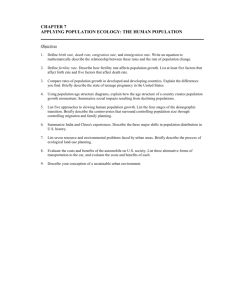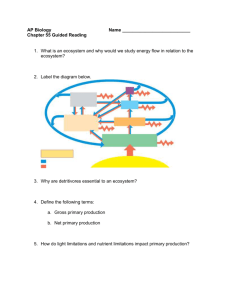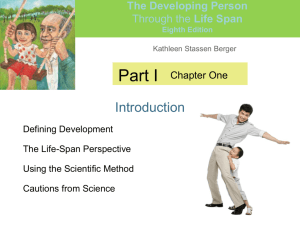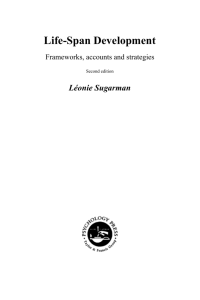Psychology 241 Fall 2009 RAT Prep #1
advertisement
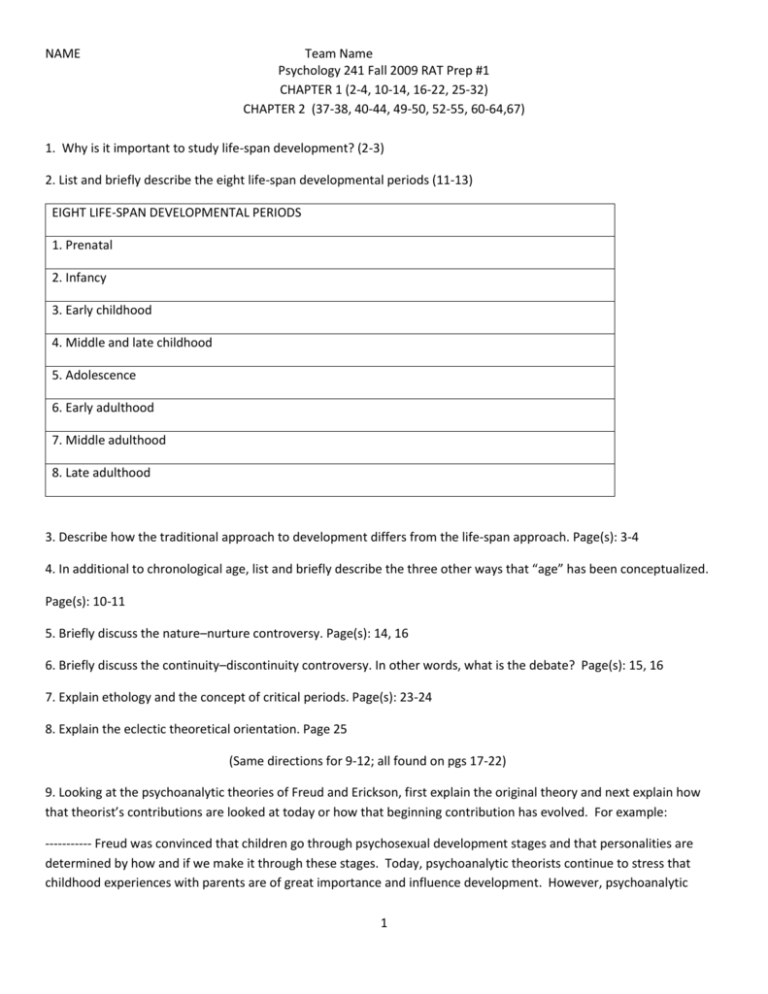
NAME Team Name Psychology 241 Fall 2009 RAT Prep #1 CHAPTER 1 (2-4, 10-14, 16-22, 25-32) CHAPTER 2 (37-38, 40-44, 49-50, 52-55, 60-64,67) 1. Why is it important to study life-span development? (2-3) 2. List and briefly describe the eight life-span developmental periods (11-13) EIGHT LIFE-SPAN DEVELOPMENTAL PERIODS 1. Prenatal 2. Infancy 3. Early childhood 4. Middle and late childhood 5. Adolescence 6. Early adulthood 7. Middle adulthood 8. Late adulthood 3. Describe how the traditional approach to development differs from the life-span approach. Page(s): 3-4 4. In additional to chronological age, list and briefly describe the three other ways that “age” has been conceptualized. Page(s): 10-11 5. Briefly discuss the nature–nurture controversy. Page(s): 14, 16 6. Briefly discuss the continuity–discontinuity controversy. In other words, what is the debate? Page(s): 15, 16 7. Explain ethology and the concept of critical periods. Page(s): 23-24 8. Explain the eclectic theoretical orientation. Page 25 (Same directions for 9-12; all found on pgs 17-22) 9. Looking at the psychoanalytic theories of Freud and Erickson, first explain the original theory and next explain how that theorist’s contributions are looked at today or how that beginning contribution has evolved. For example: ----------- Freud was convinced that children go through psychosexual development stages and that personalities are determined by how and if we make it through these stages. Today, psychoanalytic theorists continue to stress that childhood experiences with parents are of great importance and influence development. However, psychoanalytic 1 NAME Team Name theorists believe that Freud overemphasized the role of sexual instincts and instead look more closely at the affect of culture in the determinants of an individual’s development. 11. Cognitive theorists: Piaget and Vygotsky 12. Behavioral and Social Cognitive Theories: Skinner and Bandura 13. Compare and contrast behaviorism and social cognitive theory (describe the similarities and the differences between the two approaches).Page(s): 21-22 14. Briefly explain Bronfenbrenner’s Ecological Theory. (Include each system, pg 25) 15. What does it mean to conduct ethical research? (32) 16. Briefly explain the independent variable and the dependent variable in an experiment. Describe the relationship between them. Page(s): 30 17. Define theory and hypothesis. Describe the relationship between the two. Page(s): 16 18. List and describe the 5 methods for collecting data described on pgs 26-28 19. Describe and explain Correlational and experimental research. 28-30 20. Explain cohort effects, longitudinal approach, and cross-sectional approach 31-32 21. Form three hypotheses about what factors might predict academic success. Identify the variables in each hypothesis. ------Operational definitions define “the variable in terms of how it is measured, manipulated, or changed.” An operational definition is not necessarily the best definition; it is simply a measurable one. 22. Create an operational definition for each of the variables you named in the previous item. 23. Think of an analogy to describe the relationship between a hypothesis and a theory. 24. Think of three hypotheses you could test at the movies using naturalistic observation. 25. Why doesn’t correlation indicate causation? CHAPTER 2 21. In terms of Developmental Evolutionary Psychology, what does the text suggest that could help explain the obesity epidemic? (37-38) 22. Explain the connection between DNA and chromosomes? 38 2 NAME Team Name 23. In terms of differences in males and females concerning chromosomes how are we different? 40 24. Contrast phenotype and genotype: 41 25. What is meant by the term “sex linked chromosome abnormality”. Next, explain the 5 different abnormalities listed in your text. Describe the disorder and the incidence rates. 43 26. On page 44, there are 8 different gene-linked abnormalities listed. Of these 8 which do you think would be the worst to be afflicted with and why? 27. Explain the 3 aspects/periods of prenatal development. How long does each last, what occurs biologically/physically within the womb. 49-50 28. What does the term teratogen mean? List some examples of teratogens. Pg: 52-55 Although it is not a clear right or wrong answer, which teratogen do you think is the most dangerous and why? 29. Three POTENTIAL NEGATIVE OUTCOMES ASSOCIATED WITH LOW BIRTH WEIGHT IN BABIES Page(s): 67 1. 2. 3. 30. FOUR HEALTH SIGNS EVALUATED BY THE APGAR SCALE Page(s): 66 1. 2. 3. 4. 5. 31. FOUR METHODS OF DELIVERY (63-64) 1. prepared 2. natural 3. cesarean 4. medicated 32. Why is it important to understand that different cultures have varying views on pregnancy? 60 3 NAME Team Name 33. Briefly describe the 3 stages of birth. Explain the time associated with the stage and the physical/biological aspects.62 34. According to your textbook, several differences/commonalities in the childbirth setting and attendants throughout most of the world are different from those found in the USA. Please explain 2 from your text. 62-63 35. What are three types of drugs used for labor? Please explain what each drug is used for. 63 36. THREE SIGNS INDICATING PROFESSIONAL COUNSELING IS NEEDED FOR WOMEN IN THE POSTPARTUM STAGE OF PREGNANCY pg 70 1. 2. 3. 4. 4





